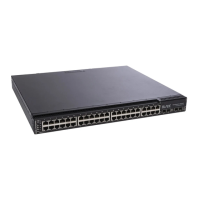© Copyright IBM Corp. 2011 Chapter 14. VMready 169
Only one VM profile can be assigned to a given distributed VM group. To change the
VM profile, the old one must first be removed using the following ISCLI configuration
command:
Note: The VM profile can be added only to an empty VM group (one that has no
VLAN, VMs, or port members). Any VM group number currently configured
for a local VM group (see “Local VM Groups” on page 166) cannot be
converted and must be deleted before it can be used for a distributed VM
group.
Assigning Members
VMs, ports, and trunks may be added to the distributed VM group only after the VM
profile is assigned. Group members are added, pre-provisioned, or removed from
distributed VM groups in the same manner as with local VM groups (“Local VM
Groups” on page 166), with the following exceptions:
•
VMs: VMs and other VEs are not required to be local. Any VE known by the
virtualization management server can be part of a distributed VM group.
•
The VM group
vlan
option (see page 167) cannot be used with distributed VM
groups. For distributed VM groups, the VLAN is assigned in the VM profile.
Synchronizing the Configuration
When the configuration for a distributed VM group is modified, the switch updates
the assigned virtualization management server. The management server then
distributes changes to the appropriate hypervisors.
For VM membership changes, hypervisors modify their internal virtual switch port
groups, adding or removing server port memberships to enforce the boundaries
defined by the distributed VM groups. Virtual switch port groups created in this
fashion can be identified in the virtual management server by the name of the VM
profile, formatted as follows:
BNT_
<VM profile name>
Adding a server host interface to a distributed VM group does not create a new port
group on the virtual switch or move the host. Instead, because the host interface
already has its own virtual switch port group on the hypervisor, the VM profile
settings are applied to its existing port group.
Note: When applying the distributed VM group configuration, the virtualization
management server and associated hypervisors must take appropriate
actions. If a hypervisor is unable to make requested changes, an error
message will be displayed on the switch. Be sure to evaluate all error
message and take the appropriate actions to be sure the expected changes
are properly applied.
Removing Member VEs
Removing a VE from a distributed VM group on the switch will have the following
effects on the hypervisor:
•
The VE will be moved to the
BNT_Default
port group in VLAN 0 (zero).
•
Traffic shaping will be disabled for the VE.
•
All other properties will be reset to default values inherited from the virtual switch.
RS G8000(config)# no virt vmgroup <VM group number> profile

